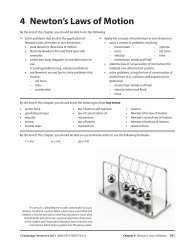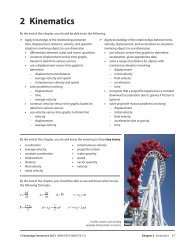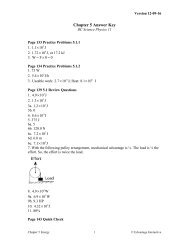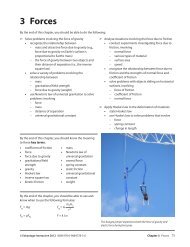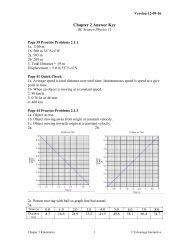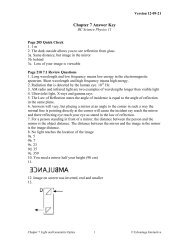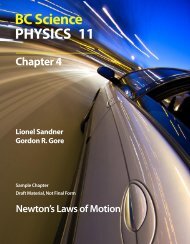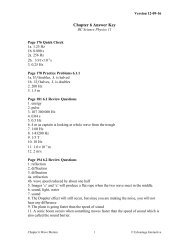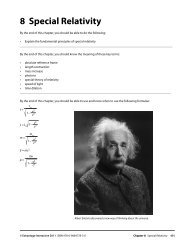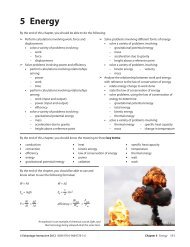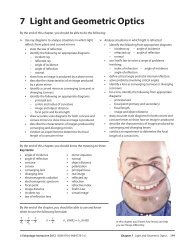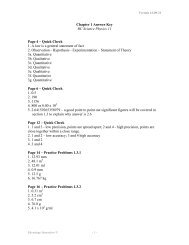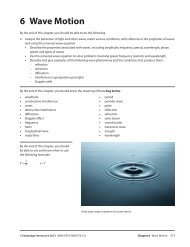1 Skills, Methods, and the Nature of Physics - BC Science Physics 11
1 Skills, Methods, and the Nature of Physics - BC Science Physics 11
1 Skills, Methods, and the Nature of Physics - BC Science Physics 11
Create successful ePaper yourself
Turn your PDF publications into a flip-book with our unique Google optimized e-Paper software.
Accuracy <strong>and</strong><br />
Precision<br />
In ano<strong>the</strong>r example, <strong>the</strong> volume <strong>of</strong> a liquid is said to be 600 mL. How precise is this<br />
measurement? Did <strong>the</strong> measurer mean it was “around 600 mL”? Or was it 600 mL to <strong>the</strong><br />
nearest millilitre? Perhaps <strong>the</strong> volume was measured to <strong>the</strong> nearest tenth <strong>of</strong> a millilitre.<br />
Only <strong>the</strong> measurer really knows. Writing <strong>the</strong> volume as 600 mL is somewhat ambiguous.<br />
To be unambiguous, such a measurement might be expressed in scientific notation.<br />
To do this, <strong>the</strong> measurement is converted to <strong>the</strong> product <strong>of</strong> a number containing <strong>the</strong><br />
intended number <strong>of</strong> significant digits (using one digit to <strong>the</strong> left <strong>of</strong> <strong>the</strong> decimal point)<br />
<strong>and</strong> a power <strong>of</strong> 10. For example, if you write 6 × 10 2 mL, you are estimating to <strong>the</strong> nearest<br />
100 mL. If you write 6.0 × 10 2 mL, you are estimating to <strong>the</strong> nearest 10 mL.<br />
A measurement to <strong>the</strong> nearest millilitre would be 6.00 × 10 2 mL. The zeros here are<br />
measured zeros, not just decimal-placing zeros. They are significant digits.<br />
If it is not convenient to use scientific notation, you must indicate in some o<strong>the</strong>r<br />
way that a zero is a measured zero. For example, if <strong>the</strong> volume <strong>of</strong> a liquid is measured to<br />
<strong>the</strong> nearest mL to be “600.” mL, <strong>the</strong> decimal point will tell <strong>the</strong> reader that you measured<br />
to <strong>the</strong> nearest mL, <strong>and</strong> that both zeros are measured zeros. “600. mL” means <strong>the</strong> same as<br />
6.00 × 10 2 mL.<br />
The number <strong>of</strong> significant digits used to express <strong>the</strong> result <strong>of</strong> a measurement<br />
indicates how precise <strong>the</strong> measurement was. A person’s height measurement <strong>of</strong> 1.895 m<br />
is more precise than a measurement <strong>of</strong> 1.9 m.<br />
Measured values are determined using a variety <strong>of</strong> different measuring devices. There are<br />
devices designed to measure all sorts <strong>of</strong> different quantities. The collection pictured in<br />
Figure 1.3.1 measures temperature, length, <strong>and</strong> volume. In addition, <strong>the</strong>re are a variety <strong>of</strong><br />
precisions (exactnesses) associated with different devices. The micrometer (also called a<br />
caliper) is more precise than <strong>the</strong> ruler while <strong>the</strong> burette <strong>and</strong> pipette are more precise than<br />
<strong>the</strong> graduated cylinder.<br />
Figure 1.3.1 A selection <strong>of</strong> measuring devices with different<br />
levels <strong>of</strong> precision<br />
Despite <strong>the</strong> fact that some measuring devices are more precise than o<strong>the</strong>rs, it is<br />
impossible to design a measuring device that gives perfectly exact measurements. All<br />
measuring devices have some degree <strong>of</strong> uncertainty associated with <strong>the</strong>m.<br />
The 1-kg mass shown in Figure 1.3.2 is kept in a helium-filled bell jar at <strong>the</strong> BIPM<br />
in Sèvres France. It is <strong>the</strong> only exact mass on <strong>the</strong> planet. All o<strong>the</strong>r masses are measured<br />
relative to this <strong>and</strong> <strong>the</strong>refore have some degree <strong>of</strong> uncertainty associated with <strong>the</strong>m.<br />
10 Chapter 1 <strong>Skills</strong>, <strong>Methods</strong>, <strong>and</strong> <strong>the</strong> <strong>Nature</strong> <strong>of</strong> <strong>Physics</strong> © Edvantage Interactive 2012 ISBN 978-0-9864778-3-6



